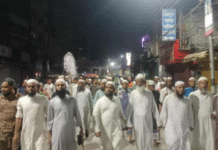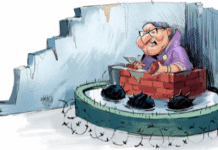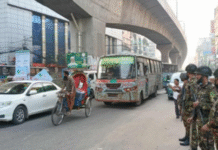Do we really need more vehicles?

Why we may be misusing the Indian Line of Credit
Given that there are some 3.8 million vehicles on Bangladesh roads and some 43,000 registered trucks and buses, many of which clog up the Dhaka city roads at different times of the day, it is baffling why another 1,000 are being pressed into service.
These vehicles are all BRTC property, provided under the Indian Line of Credit supposedly to meet a shortfall of public transport, and will run both in-city and inter-city routes.
Dhaka is already wailing and creaking under the pressure of vehicles, and unless a similar number are to be taken off the streets, this addition of transportations makes little sense.
On the contrary, more commuter foot-over bridges are the crying need of the day, to stop the habit of jaywalking and provide a safer means of crossing roads by commuters that are still willing to take the risk of weaving through traffic in search of short-cuts.
The private sector has found ways to skirt fitness regimes, bus stops, and outdated transport in meeting public demand, and resisted fielding newer vehicles for reasons best known to themselves and the authorities.
Everything that is anything has been attempted to try to control the mayhem created by public transports. The Mumbai police came and gave their suggestions, Malaysian traffic signals were installed and studiously avoided, while we still depend on traffic sergeants to direct the traffic.
They too have almost given up on motorcycles, rickshaws, and the ominous return of the legunas sporting BRTA number plates, leaving only private cars paying whatever little heed to their manual instructions.
Inter-city transport is worse with public bus terminals — a laugh for the Chittagong, Cox’s Bazaar bound buses that make road negotiation a joke at Kalabagan in late evenings.
In a country where nothing short of barriers work, more of the main roads’ adjoining footpaths need steel barriers to prevent jaywalking, junctions need monitoring to prevent people lining up for buses, and these vehicles need to be held accountable for picking passengers up from the junction.
The police are now depending on commuters to stop the practice, but the poor souls too, are tired and exhausted. The bus stops created a short while back are studiously avoided, causing them to become motorcycle parking slots without any tickets issued, and there is also the phenomenon of not enough cops on the road to enforce the law.
Ambulances jar the sound pollution peace as do VIP vehicles. While ambulances need free road space, VIP vehicles have no need to crash the party, and without doubt, it can be said that any act of parliament seeking to enforce this will be soundly voted down.
There have been improvements — the management of traffic on Bijoy Sarani road has improved after the army came up with solutions to the prime minister and maybe, just maybe, one of the three public committees — the strongest one headed by former minister and labour leader Shahjahan Khan — can tackle the traffic malady caused by the impunity with which trucks and buses cut across lanes in a race to beat one another.
Improving public transportation through the new BRTC buses will work if they have space to move in, because they are more easily accountable. Removing unfit vehicles from roads will be a major factor, because inadequate maintenance of the BRTC vehicles make themselves guilty.
Outdated cars and vehicles must be taken off the roads and scrapped. Any new cars on the road must be in proportion with the ones taken off and kept off, and scrapped under government and NGO supervision.
Mahmudur Rahman is a writer, columnist, broadcaster, and communications specialist.









